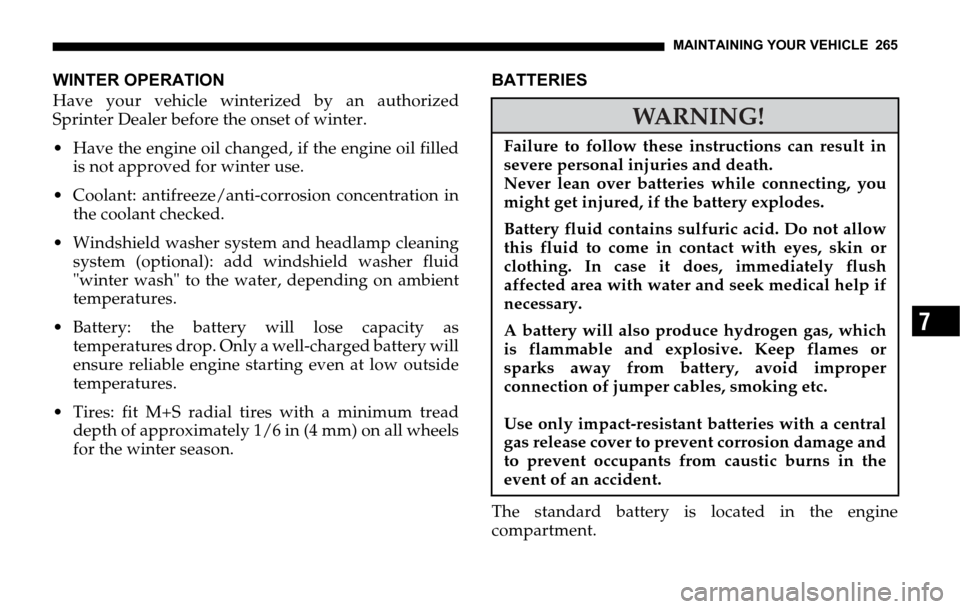Page 246 of 330

246 WHAT TO DO IN EMERGENCIES
JUMP STARTING
If the battery is dead, the engine can be started with
jumper cables from another vehicle’s battery.
WARNING!
After changing a wheel, you must, for safety reasons,
have the specified tightening torque checked. The
wheels could otherwise work loose.
check the tire inflation pressure and correct it if
necessary.
retighten the wheel bolts and wheel nuts to the
specified tightening torque once the vehicle has
been driven for 30 miles (50 km). If new or
repainted wheels are fitted, the wheel bolts or nuts
must be retightened again after about 600 to 3,000
miles (about 1,000 to 5,000 km).
have a reversed direction of tire rotation corrected
as soon as possible at a qualified specialist
workshop. The vehicle handling characteristics
could otherwise be affected.WARNING!
A battery will produce hydrogen gas, which is
flammable and very explosive. Avoid open flames
and the formation of sparks in the vicinity of the
batteries. Refrain from smoking or cell phone use.
Avoid improper connection of jumper cables.
Observe safety precautions when handling
batteries.
Exercise care near moving engine components and
electrical cables.
Failure to follow these directions will cause
damage to the electronic components and can lead
to a battery explosion and severe injury or death.
Page 247 of 330
WHAT TO DO IN EMERGENCIES 247
6
A dead battery can freeze at a temperature of 14°F
(–10°C). Never try to start the engine if the battery
is frozen. Thaw the battery out first.
Only use a battery of the same rated voltage and of
approximately the same capacity for jump-starting.
The two vehicles must not touch.
Switch off all electrical accessories.
Run the vehicle with the booster battery at idle.
Connect the jumper cables in the sequence given in
the illustration.
WARNING!
Battery fluid contains sulfuric acid. Do not allow
this fluid to come in contact with eyes, skin or
clothing. In case it does, immediately flush affect-
ed area with water, and seek medical help.
The battery housing could be damaged. Never
lean over batteries while connecting or jump-
starting. You might get injured.
Read all instructions before proceeding.
Page 248 of 330

248 WHAT TO DO IN EMERGENCIES
1. First connect the positive terminals of the two
batteries (see illustration, Items 1 + 2). Start with the
booster battery.
2. Then connect the negative terminal of the vehicle
with the booster battery to a vehicle ground point
of the vehicle with the discharged battery, such as
to the engine block (see illustration, Items 3 + 4).
Start with the booster battery.
3. Start the engine in the customary manner.
4. Allow the engine to run for a short time.
5. Before disconnecting the jumper cables from the
vehicle with the booster battery, switch on an
electrical consumer (e.g. the blower, but not the
lamps).
6. Disconnect the jumper cables in the reverse order to
that in which they were connected.
7. Disconnect the jumper cable from negative
terminal and vehicle ground point first (see
illustration, items 3 + 4), then from positive
terminals of the batteries (see illustration 1 + 2).
NOTE: Never try to start the engine with the aid of a
battery quick-charge unit.TOWING THE VEHICLE
Page 265 of 330

MAINTAINING YOUR VEHICLE 265
7
WINTER OPERATION
Have your vehicle winterized by an authorized
Sprinter Dealer before the onset of winter.
Have the engine oil changed, if the engine oil filled
is not approved for winter use.
Coolant: antifreeze/anti-corrosion concentration in
the coolant checked.
Windshield washer system and headlamp cleaning
system (optional): add windshield washer fluid
"winter wash" to the water, depending on ambient
temperatures.
Battery: the battery will lose capacity as
temperatures drop. Only a well-charged battery will
ensure reliable engine starting even at low outside
temperatures.
Tires: fit M+S radial tires with a minimum tread
depth of approximately 1/6 in (4 mm) on all wheels
for the winter season.BATTERIES
The standard battery is located in the engine
compartment.
WARNING!
Failure to follow these instructions can result in
severe personal injuries and death.
Never lean over batteries while connecting, you
might get injured, if the battery explodes.
Battery fluid contains sulfuric acid. Do not allow
this fluid to come in contact with eyes, skin or
clothing. In case it does, immediately flush
affected area with water and seek medical help if
necessary.
A battery will also produce hydrogen gas, which
is flammable and explosive. Keep flames or
sparks away from battery, avoid improper
connection of jumper cables, smoking etc.
Use only impact-resistant batteries with a central
gas release cover to prevent corrosion damage and
to prevent occupants from caustic burns in the
event of an accident.